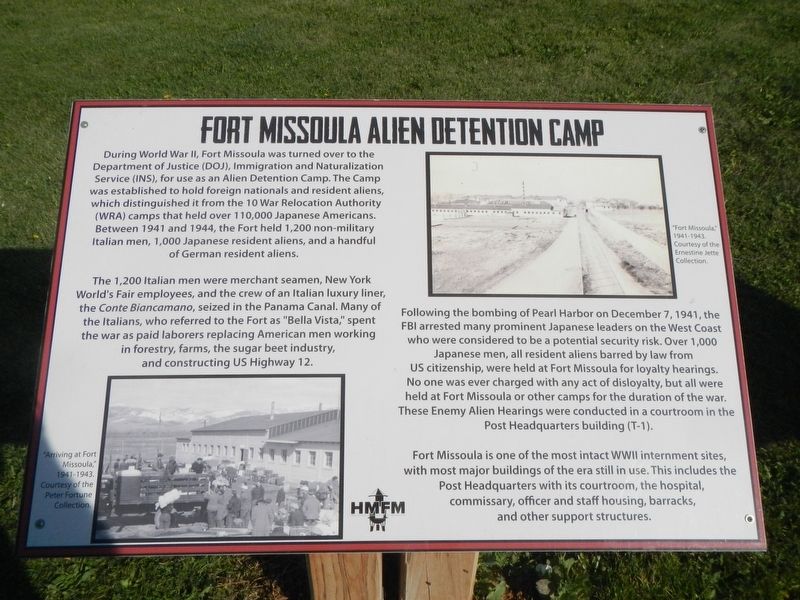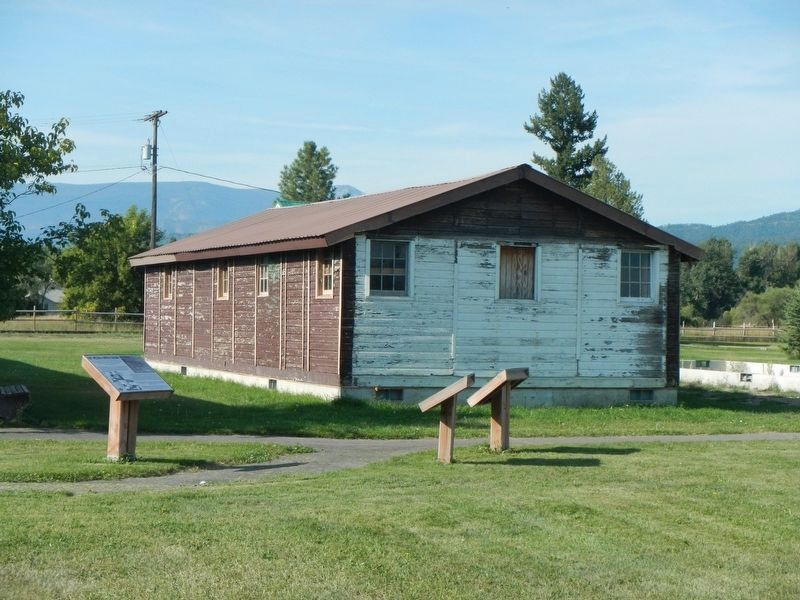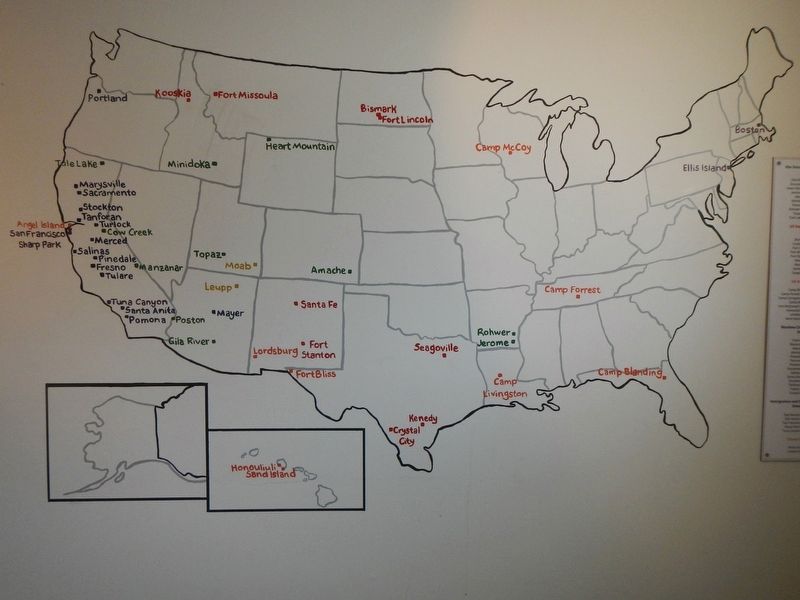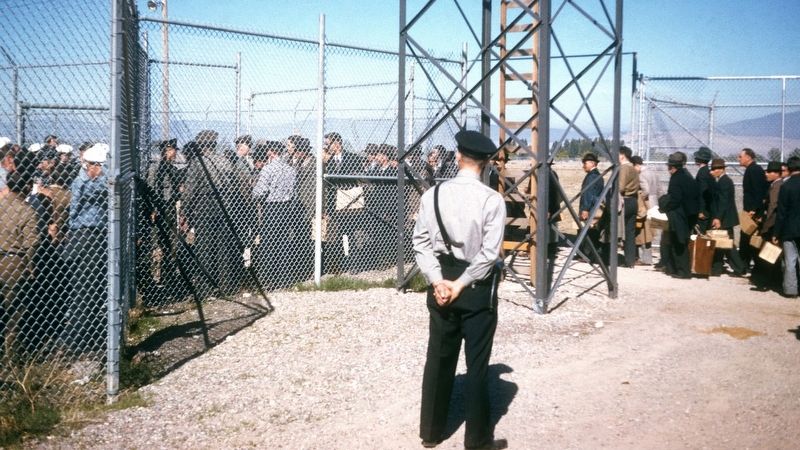Missoula in Missoula County, Montana — The American West (Mountains)
Fort Missoula Alien Detention Camp
Inscription.
During World War II, Fort Missoula was turned over to the Department of Justice (DOJ), Immigration and Naturalization Service (INS), for use as an Alien Detention Camp. The Camp was established to hold foreign nationals and resident aliens, which distinguished it from the 10 War Relocation Authority (WRA) camps that held over 110,000 Japanese Americans. Between 1941 and 1944, the Fort held 1,200 non-military Italian men, 1,000 Japanese resident aliens, and a handful of German resident aliens.
The 1,200 Italian men were merchant seamen, New York World's Fair employees, and the crew of an Italian luxury liner, the Conte Biancamano, seized in the Panama Canal. Many of the Italians, who referred to the Fort as "Bella Vista," spent the war as paid laborers replacing American men working in forestry, farms, the sugar beet industry, and contracting US Highway 12.
Following the bombing of Pearl Harbor on December 7, 1941, the FBI arrested many prominent Japanese leaders on the West Coast who were considered to be a potential security risk. Over 1,000 Japanese men, all resident aliens barred by law from US citizenship, were held at Fort Missoula for loyalty hearings. No one was ever charged with any act of disloyalty, but all were held at Fort Missoula or other camps for the duration of the war. These Enemy Alien Hearings were conducted in a courtroom in the Post Headquarters building T-1.
Fort Missoula is one of the most intact WWII internment sites, with most major buildings of the era still in use. This includes the Post Headquarters with its courtroom, the hospital, connivery, officer and staff housing, barracks, and other support structures.
Erected by Historical Museum at Fort Missoula.
Topics. This historical marker is listed in these topic lists: Forts and Castles • War, World II.
Location. 46° 50.581′ N, 114° 3.576′ W. Marker is in Missoula, Montana, in Missoula County. Marker is on D Road near Fort Missoula Road, on the left when traveling north. Touch for map. Marker is at or near this postal address: 1203 D Road, Missoula MT 59804, United States of America. Touch for directions.
Other nearby markers. At least 8 other markers are within walking distance of this marker. A different marker also named Fort Missoula Alien Detention Camp (a few steps from this marker); Fort Missoula Barrack Building (a few steps from this marker); Fort Missoula Post Headquarters (about 400 feet away, measured in a direct line); T-1 Post Headquarters (about 400 feet away); Post Headquarters (about 500 feet away); Fort Missoula Post Headquarters (T-2) Building (about 500 feet away);
Parade Grounds (about 500 feet away); 1877 Fort Missoula Officers' Club (about 600 feet away). Touch for a list and map of all markers in Missoula.
More about this marker. This marker is located on the grounds of Fort Missoula near the barrack building and Alien Detention Camp exhibit.
Also see . . .
1. An Alien Place: The Fort Missoula Detention Camp 1941-1944 -- MontanaPBS. A twenty-five minute documentary on the Fort Missoula Alien Detention Center. (Submitted on January 12, 2020, by Barry Swackhamer of Brentwood, California.)
2. Fort Missoula Alien Detention Camp -- Fort Missoula Museum. Fort Missoula’s ADC was established to hold foreign nationals and resident aliens, to distinguish it from the 10 better known War Relocation Act camps that held 120,000 Japanese Americans. The Italian men were merchant seamen, World’s Fair employees, and the crew of the Italian luxury liner, the Conte Biancamano, seized in the Panama Canal. Many of the Italians, who referred to the Fort as “Bella Vista,” spent the war as paid laborers replacing... (Submitted on January 12, 2020, by Barry Swackhamer of Brentwood, California.)
3. When the U.S. Interned Italians in Montana, They Rioted Over Olive Oil -- Atlas Obsura
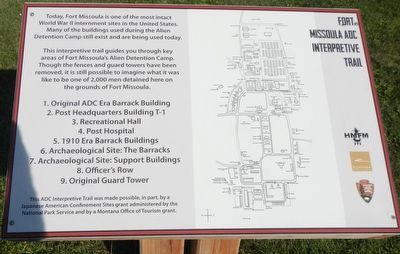
Photographed By Barry Swackhamer, August 21, 2019
3. Fort Missoula ADC Interpretive Trail
This marker is located on the grounds of Fort Missoula.
Today, Fort Missoula is one of the most intact World War II interment sites in the United States. Many of the buildings used during the Alien Detention Camp still exist and are being used today.
This interpretive trail guides you through key areas of Fort Missoula's Alien Detention Camp. Though the fences and guard towers have been removed, it is still possible to imagine what it was like to be one of 2,000 men detained here on the grounds of Fort Missoula.
1. Original ADC Era Barrack Building
2. Post Headquarters Building T-1
3. Recreational Hall
4. Post Hospital
5. 1910 Era Barrack Buildings
6. Archaeological Site: The Barracks
7. Archaeological Site: Support Buildings 8. Officer's Row
9. Original Guard Tower
This interpretive trail guides you through key areas of Fort Missoula's Alien Detention Camp. Though the fences and guard towers have been removed, it is still possible to imagine what it was like to be one of 2,000 men detained here on the grounds of Fort Missoula.
1. Original ADC Era Barrack Building
2. Post Headquarters Building T-1
3. Recreational Hall
4. Post Hospital
5. 1910 Era Barrack Buildings
6. Archaeological Site: The Barracks
7. Archaeological Site: Support Buildings 8. Officer's Row
9. Original Guard Tower
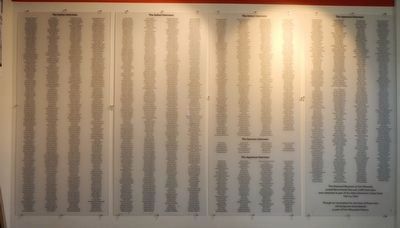
Photographed By Barry Swackhamer, August 21, 2019
4. List of Detainees
The Historical Museum at Fort Missoula
would like to honor the over 2,000 men who were
detained as a part of the Alien Detention Center from
1941 to 1944.
Though an incomplete list, the lives of these men
will alway be remembered
as part of Fort Missoula History.
would like to honor the over 2,000 men who were
detained as a part of the Alien Detention Center from
1941 to 1944.
Though an incomplete list, the lives of these men
will alway be remembered
as part of Fort Missoula History.
Credits. This page was last revised on January 12, 2020. It was originally submitted on January 12, 2020, by Barry Swackhamer of Brentwood, California. This page has been viewed 194 times since then and 20 times this year. Photos: 1, 2, 3, 4, 5, 6. submitted on January 12, 2020, by Barry Swackhamer of Brentwood, California.
